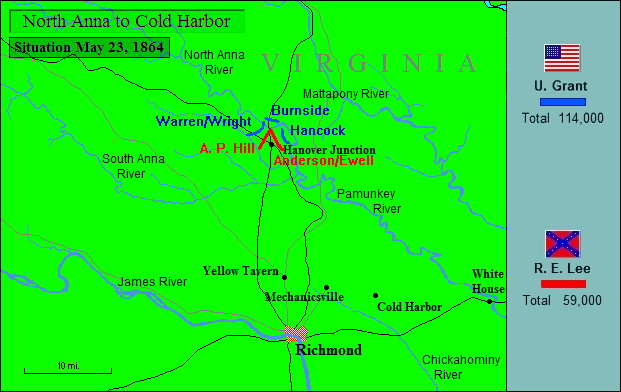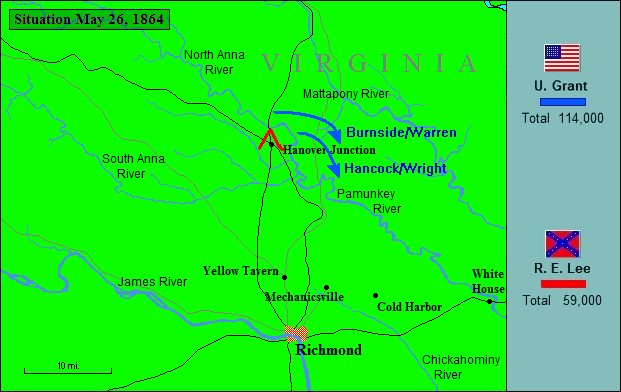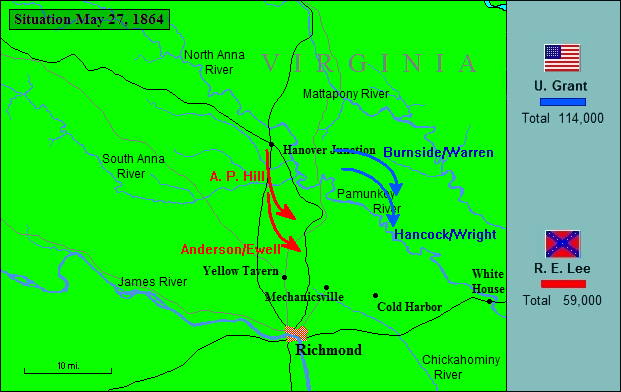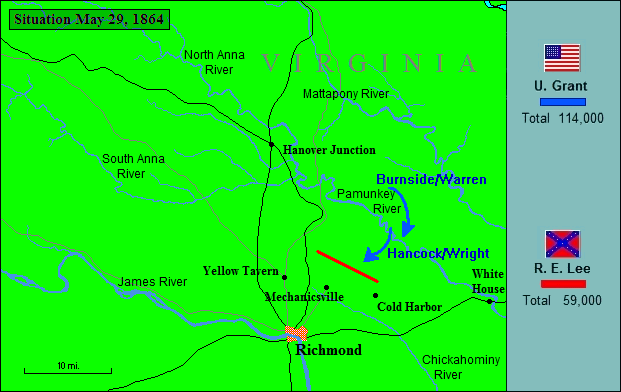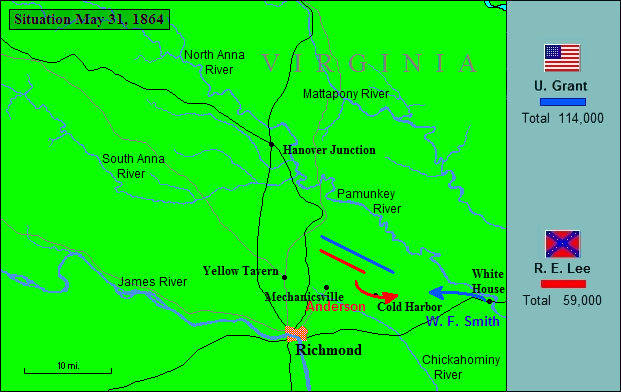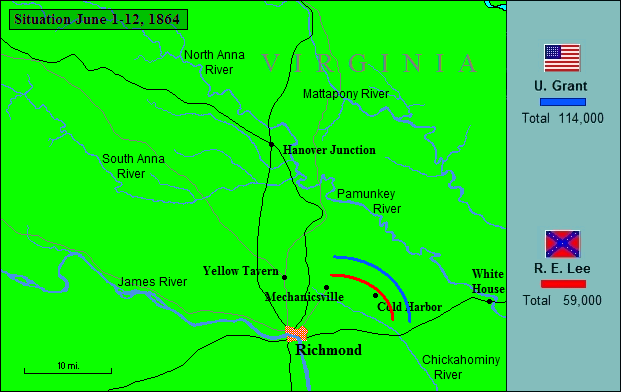Grant, convinced by now of the impossibility of turning Lee at Spotsylvania, decided to shift the killing ground once more. It was to be another race to the south and east, this time to Hanover Junction where the Virginia Central line crossed the Richmond, Fredericksburg, and Potomac just below the North Anna River. Lee, however, was alert to the danger, despite an increasingly debilitating intestinal ailment. On May 19 a Rebel reconnaissance in force clashed with bluecoats and discovered Grant’s movement. Lee hustled his army down behind the North Anna, where in six swift hours they threw up those formidable works the Yankees had learned to dread. Lee’s army was now drawn up in a north-facing inverted-V behind the river, Hill on the western leg, Anderson at the apex, and Ewell on the east. On the Federal side Wright and Warren, after a brief, bloody clash with A. P. Hill, had got over the river at Jericho Mills and were now skirmishing down opposite Hill on Lee’s left; Hancock had crossed at the Chesterfield Bridge downriver and was now moving up opposite Ewell on Lee’s right; Burnside was in reserve north of the river opposite Anderson. If Grant was going to give battle here, he would do so against long odds. Not only were the works formidable, fronted by slashings and abatis, but the inverted-V meant that Lee could reinforce either wing easily while either wing of Grant’s army would have to cross the river twice to reinforce the other. Lee’s potentially vulnerable angle in the center could not be assaulted successfully because it fronted the river and was backed by guns on its high south bank. Lee, however, did not have defense in mind. The very same reasons that made this position sound for defense made it just as sound for offense. Grant had in effect split his army in two on the wedge of the North Anna works. If Lee was going to drive those people, here was the opportunity. Holding his lines with a sketchy force on one wing, he could fall with a massive force on either isolated wing of Grant’s. By the time Federal reinforcements crossed the river twice, the damage would be done.
This plan of attack was precisely what Lee intended, but much to his impotent dismay, it never happened. It was a simple story of the frailty of human flesh. Lee’s intestinal disorder was at first severe enough to keep him from horseback; by the third week of May, he was sick enough to be confined to his cot. He was frankly in misery, from his bowels of course but more so from frustration. “We must strike them a blow,” he muttered again and again. “We must never let them pass us again. We must strike them a blow!” But of the two men who might strike the intended blow in Lee’s stead, Jackson was in his grave and Longstreet in the hospital. A. P. Hill was pale and weak with illness himself, and one-legged Ewell–even in vigorous health perhaps not a good candidate–was ailing likewise, apparently with the same disorder that had Lee prostrate. That left indecisive Dick Anderson who had been a corps commander barely three weeks. In the end, Lee realized the danger of his position, and the Federals opposite also entrenched to the eyes. What would prove Lee’s last real opportunity to seize the initiative came and went on the banks of the North Anna River.
The race down to the North Anna had taken Grant another twenty-five miles closer to Richmond, added another 2,000 to his casualty list and not quite half that to Lee’s, but it had not brought Lee out for the stand-up fight he intended. After two days of digging below the North Anna, Grant made up his mind to make one more run around Lee’s right. He would shift his base of supply to White House on the Pamunkey River, feint a crossing of the North Anna upriver, then drive south and east once more, swinging west at last to fetch up in the neighborhood north of Richmond. “Lee’s army is really whipped,” Grant wired Halleck. “The prisoners we now take show it, and the actions of his army show it unmistakably. A battle with them outside of entrenchments cannot be had.” For his part, Lee did not believe that he or his army were at all whipped. At nearly the same time Grant was pronouncing him whipped, Lee declared, “If I can get one more pull at [Grant], I will defeat him.” The two great commanders were utterly alike in the hard core of confidence they had in themselves and the men they led. On May 26 Grant made noisy demonstrations on both wings and sent a division of cavalry upriver to feint a crossing. Then with Wright and Warren in the lead and Hancock and Burnside following, he headed for Hanovertown where he intended to cross the Pamunkey and drive toward Richmond. This was a race, however, that he could not win. While Grant marched on a wide southeast arc, Lee marched on the chord of the arc. Thus, by the time his lead corps reached Totopotomy Creek nine miles northeast of Richmond on May 28, they found Rebels behind it entrenched, as ever, to the eyes.
If the prospect looked dreadful to Grant’s weary men who had been fighting and marching for nearly a month now, the implications for Lee looked even more perilous. He knew now two more disturbing facts: one, Grant had secured his White House base, and, two, Baldy Smith’s corps was already headed there on transports from Butler on Bermuda Hundred. He would be soon ready to march west in support of Grant’s left. If he marched on Cold Harbor just east of Richmond, Lee would have four enemy corps on his front on Totopotomy Creek and a fifth in his rear. Lee now sent a wire to Richmond that included a word he hadn’t used since Gettysburg: disaster. If Beauregard didn’t send help from Bermuda Hundred, disaster was at hand. It was an unflinching word, and it struck a nerve: the same day Robert Hoke’s division was on the cars and on the way. To Cold Harbor in his rear Lee sent Fitzhugh Lee’s cavalry with orders to hold the place until infantry could get down to support them. At the same time, the immediate threat on Lee’s front remained critical. From his sick bed Lee had insisted that the Federals must not pass his army again. He was, if anything, surer now: “We must destroy this army of Grant’s before he gets to the James River,” he told Jubal Early. “If he gets there it will become a siege, and then it will be a mere question of time.” To Jubal Early, now in corps command in place of the ailing Ewell, fell the task of destroying Grant.
The destructive blow Lee intended, however, turned out to be the merest tap, or rather merest by the new standards of slaughter this campaign was establishing. Early sent one of his three divisions forward against the Union left in the neighborhood of Bethesda Church on May 30 and made some headway, but before he could get his other two into the fight, he was struck a sharp counterattack. It was all he could do to hold his own ground with Anderson’s help. In the end, however, the disputed ground was a moot point because Grant did not like the lay of it and had made up his mind to try to turn Lee’s right again, swinging to his own left once more, to Cold Harbor this time, a crossroads town just northeast of Richmond and just east of the Gaines Mill battlefield of ’62. From Cold Harbor Grant could drive west toward Richmond, pushing Lee’s army into Powhite Creek in its rear in the process, he hoped. Lee’s nephew, Fitzhugh Lee, was of course already there with his cavalry. Accordingly, on May 30 Grant sent his own cavalry chief, hard-riding Phil Sheridan, to clear them out. Foot soldiers were fond of asking derisively, ‘Who ever saw a dead cavalryman?’ But this latest drive from Spotsylvania down to the Chickahominy was using up troopers at a furious clip. First, there was the battle at Yellow Tavern back on May 11 where Stuart had been killed. On May 28 blue and grey horsemen had a wearing seven-hours’ fight at Haw’s Shop in front of the Federal advance down to the Totopotomy. Now on the 31st Fitz Lee and Little Phil were locked in a fierce all-day contest for possession of Cold Harbor.
The fight turned out to be more a clash of mounted infantry than slashing cavalrymen. When Sheridan reached the field that morning, he found Fitz Lee’s two brigades dismounted and dug in east of the town. Head-on charges by Wesley Merritt and George Armstrong Custer failed to budge the grey troopers despite the Yankees’ rapid-fire carbines. Sheridan then dismounted his men himself, and they came forward to shoot it out with the Rebels behind their breastworks. Had there been any infantrymen on the field, they would have seen plenty of dead cavalrymen this day. In fact, both Fitz Lee and Little Phil were looking over their shoulders all day for the infantry support they expected, Hoke’s grey division and Baldy Smith’s blue corps both on the way from Bermuda Hundred. In the hurry to disengage from the Totopotomy lines, however, Smith had been misdirected and would never reach the field that day. Hoke did come up with his lead brigade at dusk, and ironically these reinforcements cost Fitz Lee his position. As darkness drew on, the blue troopers were massing for a final rush against Lee’s line, but just then Hoke’s lead brigade was coming up through the town. Thinking to fall back on firm infantry support, the dismounted Rebels withdrew from their lines, a withdrawal that the foot soldiers mistakenly took to be a general retreat. It didn’t take long for it to become a retreat in fact as Little Phil was quick to push and keep on pushing. Sheridan’s men pressed on through the town, gathering up laggard Rebels as they went and taking up a new line west of Cold Harbor. By dark the crossroads town that had been so stubbornly defended all day was in Union hands.
Whether the Federals could hold the place when Hoke’s three following brigades came up was another question, and Sheridan frankly thought not. “I do not feel able to hold this place,” he told Meade. “With the heavy odds against me here, I do not think it prudent to hold on.” But since Cold Harbor was the next step in Grant’s bloody progress south, it had to be held, as Meade insisted, “at all hazards.” In doing so, Sheridan would get unexpected help–from Rebel incompetence across the way. In truth, the Army of Northern Virginia was not what it had been on the 4th of May when Grant crossed the Rapidan. Although reinforcements sent to his army had about made up his battle losses, two corps commanders, four division commanders, and sixteen–very nearly half the total–brigade commanders were out of action by June 1st, not to mention the fact that the army commander himself was too sick to ride just when more and more of the burden of command fell on him alone. Prying Sheridan’s dismounted horsemen loose from Cold Harbor should have been short work on the morning of June 1. Hoke’s division was in line and Joe Kershaw’s had come up on his left. But when Kershaw’s first brigade went forward into the rapid fire of Federal carbines, a green South Carolina regiment in the center broke up at the first blow. A Rebel artilleryman thought it “the most abject rout ever committed by men in Confederate uniform.” The panic spread to the veteran regiments on either flank, and when, unaccountably, Hoke failed to move at all on the right, the whole affair collapsed. Kershaw tried once more shortly before mid-morning, succeeding only in killing more Confederates. By that time Wright’s three blue divisions were up, and like all veterans, blue or grey, they knew that a spade was as valuable as a rifle. Sheridan’s works were readily entrenched and extended in a long line north and south just west of Cold Harbor.
On the morning of June 2, both armies were now coming up and filing into line as Grant and Lee pondered their next moves. As Lee swung his strength south from Totopotomy Creek to confront Grant’s latest sidling move to the Federal left, he laid out a seven-mile line. It ran from Pole Green Church on the north, very nearly on the banks of the creek, to Grapevine Bridge over the Chickahominy to the south. One of Hill’s divisions would anchor the northern end of the line at Pole Green Church while the other two anchored the southern end on the Chickahominy. Between them, Early’s divisions would hold the left-center and Anderson’s right-center. It was a line, when completed, calculated to offer excellent interlocking fields of fire. Although Lee had not so much as a regiment in reserve, in the trenches would be nearly 60,000 men, roughly the number Lee began the campaign with. (Lee had even drafted the walking wounded from his field hospitals.) Grant had pronounced these men whipped a week before, but in fact they liked this ground very much and wanted nothing better than to be attacked across it. Coming up across the way were Grant’s 110,000 bluecoats, roughly the number he began the campaign with despite his 44,000 casualties. His five corps were now aligning north to south: Burnside just north of the Old Church Road, then Warren, Smith, and Wright, with Hancock anchoring the southern end just above the Chickahominy as soon as he reached the field.
Grant had declared his intention to fight it out on this line if it took all summer. Now it looked to Grant that he would have to find a way to break this line if he were to bring this campaign to a successful conclusion. Constantly moving to his left for a month now, he had tried to bring Lee out of his trenches for a stand-up fight in the open. Yet here was the grey fox once more entrenched across the road to Richmond. Now there was no more room to the left unless Grant intended to march through the jungles of the Chickahominy bottoms where McClellan had come to grief back in ’62. If Lee’s men were truly whipped and the morale of his own men still sound, a massive assault, all five corps in a pile-driver attack, must, Grant believed, break Lee somewhere and fling him back on his capital. As the sultry second day of June drew on toward afternoon, Grant and Lee both did a bit of sparring to improve their positions. About 3:00 Lee sent two brigades under Breckinridge with a division from Hill in support to drive Yankees off Turkey Hill between Gaines Mill and Cold Harbor. (Two years earlier Fitz-John Porter’s corps had been driven from it at the Battle of Gaines Mill.) From this high ground, Rebel guns could pound the Federal left. At the same time Early and Hill’s men were probing the Yankee lines between the Old Church Road and Totopotomy Creek. On the Federal side, Meade sent six divisions against Anderson’s front about 5:00 while the Rebels were still digging. Here the bluecoats briefly punched a hole in the Confederate line, but by sunset it was restored slightly to the rear. At a cost of more than two thousand casualties, the Federals narrowed somewhat the ground Grant intended to attack across in the morning.
What Grant thought of attacking over this ground was one thing; what the rest of his army thought quite another. The plan was simple enough: Burnside and Warren would hold the Confederates on the northern end of the line, while three corps, the 60,000 men with Smith, Wright, and Hancock, would deliver the breakthrough blow on the Confederate center and right-center where the lines were closest. And that was that. Neither Grant nor Meade, however, had seen the ground with his own eyes, nor made any provision for the cooperation of the three corps responsible for the main effort. Baldy Smith admitted to being “aghast at the reception of such an order, which proved conclusively the utter absence of any military plan.” The extent of Federal preparation was this directive from Meade: “Corps commanders will employ the interim in making examinations of the ground on their front and making perfect the arrangements for the assault.” In the end, each corps would be on its own and left to its own fate. It may be simply that after a month of fighting and marching Grant and Meade were as numb with fatigue as their bone-weary men. Or it may be that Grant genuinely believed that Lee was already beaten and that one more blow would fold him up. The men in the ranks who had seen the ground with their own eyes believed no such thing. On the rainy night of June 2, Horace Porter noted, the men “were calmly writing their names and home addresses on slips of paper and pinning them on the backs of their coats, so that their bodies might be recognized and their fate made known to their families at home.” Surrendering to this dark foreboding, one soldier wrote in his diary the next day’s entry: “June 3. Cold Harbor. I was killed.” The diary, stained with blood, was later found in the dead man’s pocket.
The Federals were ready at first light on the drizzly morning of June 3, and at 4:30 stepped off into slaughter. The Confederates could see them coming in the grey dawn and were frankly eager to have them close. “Our officers had great difficulty in restraining the men from firing too soon,” a Rebel recalled, “but when close enough, the word ‘fire’ was given, and the men behind the works raised deliberately… and fired volley after volley.” John B. Gordon, who remembered well the “dreadful carnage” before Marye’s Heights at Fredericksburg, admitted that he “had seen nothing to exceed this. It was not war; it was murder.” Long tearing volleys of rifle fire and screaming shells mangled the Union lines as fast as they could come forward. To a Federal artilleryman, it was “the fury of Wilderness musketry with the thunders of the Gettysburg artillery superadded.” The fire on the Federal front was perhaps as severe as any the war had seen, but with three corps aiming at three different points and making essentially three separate attacks, Rebel enfilade fire was especially destructive. Hancock’s left flank was mauled, Smith’s right, and Warren both right and left. “I could see the dust fog out of a man’s clothing in two or three places,” one Rebel rifleman remembered, “where as many balls would strike him at the same moment.” Only in one place did Grant’s breakthrough attack actually penetrate the Confederate line. Barlow’s division with Hancock on the Federal left briefly drove Breckinridge’s brigades from their lines, but a swift and savage counterattack sent the survivors streaming back. For the Yankees, it was a hopeless business all along the line. In the face of that merciless fire, they “halted and began to dodge, lie down, and recoil,” a defender recalled; “the dead and dying lay in front of the Confederate line in triangles, of which the apexes were the bravest men who came nearest to the breastworks under that withering, deadly fire.” The Federal attack had lasted just eight ghastly minutes. Before the day was out Grant would number some 7,000 casualties.
But, incredibly–insanely, thought the men on the firing line–Grant ordered the attack renewed. When the orders reached the corps commanders, each registered the same protest: he could not attack unless supported by the advance of the others, an advance that the first eight minutes of the attack had proved impossible. If the three corps could not attack in concert, Grant insisted, each must advance alone. In the end, all that the Federals could manage was to lie prone in the field, dig in to the extent they could, and keep up a largely ineffective fire while the Rebels maintained their murderous work. By 1:30 even Grant was willing to admit he was using up his army to no useful end: “For the present, all further offensive operations will be suspended.” In fact, offensive operations had been suspended by the common consent of the attackers for nearly nine hours. “I regret this assault more than any one I ever ordered,” Grant told his staff that night. There were acres of dead men in blue between the lines who were now past all regretting; lying among them were the thousands of maimed whose ordeal had just begun.
There was a steely stubbornness in Grant’s character, and it had been a virtue last year in his long campaign against Vicksburg. It was, on one hand, a fundamental unwillingness to admit defeat, and, on the other, a firm resolve to keep battering until the other side broke. To ask for a truce now to collect his dead and wounded was, to Grant’s mind, an admission of defeat. For two long, hot June days, the dead rotted on the field and the wounded cried for help, at first with cries clear and terrible, then, as they weakened, in muted tones of misery. A Rebel deserter grimly supposed that Grant was going to try to stink Lee out of his lines. On June 5, he at last proposed to Lee that litter parties be allowed on the field to gather the wounded “probably of both armies.” Lee of course was well aware that the only wounded men in that merciless heat wore blue, and he would agree to no such thing. Ask for a suspension of hostilities under a flag of truce in the customary way, Lee answered, and it would afford him pleasure to comply. Grant tried another such evasion the next day which Lee again politely parried. On the 6th, Grant finally buckled and sent the flag of truce across the lines, the symbol of defeat. By the time Lee’s approval came back in response it was the morning of the 7th. When the Federal litter parties went out, they found just two living men among the holocaust. Some few had crawled to safety or been fetched in the night by friends. The rest had perished.
It is hard to gauge fully the effect of Cold Harbor on the Army of the Potomac, and not just of Cold Harbor’s slaughter, but of the more than thirty days now of continuous marching, digging, fighting, a long stretch without so much as a whole night’s sleep or a bath. “For thirty days,” Gouverneur Warren fumed, “it has been one funeral procession past me, and it has been too much!” Grant had lost two men to one of Lee’s, losses that worked out to some two thousand casualties a day. The papers back home were beginning to call Grant a butcher, and the Copperheads cast him as a “bull-headed Suvarov,” after the eighteenth-century Russian field marshall who had used up his troops freely. The boys who bore the burden of this badly managed Cold Harbor assault were not so sure now that they weren’t right. The British observer who had witnessed the crack-up of Pickett and Pettigrew’s brigades at Gettysburg had thoughtfully predicted that the Army of Northern Virginia would never charge with such spirit again. Nor would the Army of the Potomac after Spotsylvania and Cold Harbor. “The men feel at present a great horror and dread of attacking earthworks again,” one Federal officer observed. A private soldier spoke more simply for his comrades: we were all done attacking Rebel works, he explained. We would run at them, then run back. “Many a man,” wrote young Oliver Wendel Holmes, Jr., “has gone crazy since this campaign began from the terrible pressure on mind & body.”
The Army of the Potomac was temporarily in shock, and the conditions under which it now warily confronted its adversary were not likely to encourage a quick recovery. In the oppressive heat of early June, they were burrowing in the earth like animals, filthy and exhausted, with various vermin for unwelcome company. If there was any consolation, it was only that the Rebels across the way were in much the same misery only less well-fed. With the lines as close as they were, both sides suffered steady daily attrition from sniper fire. This both Billy Yank and Johnny Reb equally resented as a kind of capricious killing; stalemated as they were for the moment, sniper fire could not possibly do anything except add to the long roll of the maimed and the dead, their widows and orphans.
At Cold Harbor U. S. Grant had been compelled to send his flag of truce and admit at the least that he had been checked–checked but not mated by a long stretch. If Lee could not be broken here, perhaps blows struck elsewhere could assist in maneuvering Lee out of his lines once more. David Hunter (in command now for the unfortunate Sigel) was already moving up the Shenandoah Valley with a force of 15,000 Federals. Grant now ordered him to continue his southward advance, wrecking the railroad as he went, to Lynchburg to destroy Confederate supplies gathered there. Meanwhile, two divisions of Sheridan’s horsemen would swing west into the Valley likewise wrecking as they rode. Somewhere in the middle Valley Sheridan would join Hunter for a combined thrust east toward Richmond, breaking the rail link between the capital and the Valley. Lee’s short rations would be shorter yet and his embattled army would have a fire in its rear. The decisive move of course would be Grant’s. He would slip his trenches at Cold Harbor, make a hard march around Lee’s right once more, and cross the Chickahominy. Instead of turning west toward Richmond and risk floundering in the Chickahominy bottoms, he would drive on with all deliberate speed over the James and on to Petersburg to the south. The plan would seal the Valley off and put Grant astride Richmond’s last rail link to the Carolinas and the Deep South at Petersburg. If all went well, Lee must, Grant reasoned, starve or fight.
For the Federals, however, all did not go well, though Hunter’s first moves boded well enough. Hunter drove up the Valley to Piedmont, just north of Staunton, and crushed a small force there, scooping up 1,000 prisoners on June 5. He moved on south, through Staunton to Lexington, but the farther south he marched, the more vigorous were partisan raids in his rear. Short on rations, ammunition, and patience, the bluecoats on June 12 dealt with Lexington with a hard hand. These men were largely Valley veterans with long experience of John Singleton Mosby’s partisans. To many Southerners, Mosby and his hard-riding raiders were heroic cavaliers; to the Yankees, they were bushwhackers and worse. In any case, Lexington now paid the price for more than three years of guerrilla war in the Valley. Hungry Federal soldiers foraged freely, foraging became looting, and before long much of Lexington was wreckage. The Virginia Military Institute, where Thomas J. Jackson had been an eccentric instructor of mathematics in those far-off days of peace, went up in flames, joined soon after by the home of Virginia Governor John Letcher. Hunter marched on to Lynchburg by the 17th, but by then Lee, alive to the danger of losing control of either the Southside Railroad at Lynchburg or the Virginia Central at Charlottesville or both, had detached Jubal Early and his corps and sent them with all dispatch to the Valley. Early’s three divisions, fittingly Jackson’s old Army of the Valley, were now firmly in place before Lynchburg. Hunter skirmished a bit on June 17 and 18, and then, perhaps prudently worried about his shortage of ammunition, withdrew, not back down the Valley but into West Virginia and out of the campaign. Hunter, as it happened, had been wounded at First Bull Run. Perhaps he had forgotten the mischief Joe Johnston’s brigades had wrought there when Robert Patterson had taken his bluecoats out of the Valley, into what was then western Virginia, and out of the war. In any case, Hunter could not know that Robert E. Lee had given Old Jubal permission to use the Valley as his famous predecessor had, as a broad and fertile highway of invasion that ran down to Washington.
In the meantime the commander Hunter was supposed to join, Sheridan, was riding a swinging arc from the east along the north bank of the North Anna. His 7,000 troopers were headed for Gordonsville, where they hoped to tear up the Virginia Central between that place and Louisa Courthouse to the east before joining Hunter for a march toward Richmond. While Sheridan was making his long swing north and west, however, 5,000 Confederate troopers now under Wade Hampton had simply to ride a straight course northwest from Atlee along the north bank of the South Anna. Thus, by the time Sheridan reached Trevillian Station, still eight miles shy of Gordonsville, Hampton was already there and ready to give battle. The collision came early on the morning of June 11 as Hampton’s two small divisions attacked, setting off a big, bloody, hopelessly confused cavalry fight. Each side hammered away and was hammered in return until the fight broke off toward dusk with Rebels withdrawing both east and west. The next morning Sheridan hoped to continue his advance westward along the Virginia Central to Gordonsville, but Hampton’s divisions had reunited in the night and were now firmly dug in just northwest of Trevillian. Sheridan dismounted his men and sent them on foot against the Rebel works, where they were bloodily repulsed as many times as they attacked. With no sign of Hunter (who was still making his way up from Staunton and about to run into Old Jubal), Sheridan gave up the raid as a piece of bad business. At a cost of 1,500 troopers (to Hampton’s 1,100), Sheridan had torn up four miles or so of track in the direction of Louisa. After dark on June 12, he slipped away to recross the North Anna and return the way he came. In the end, the entire operation would accomplish little but the shedding of more blood. By the time the blue raiders crossed the Pamunkey a week later, the Virginia Central was open again and carrying supplies to Lee’s army once more.

